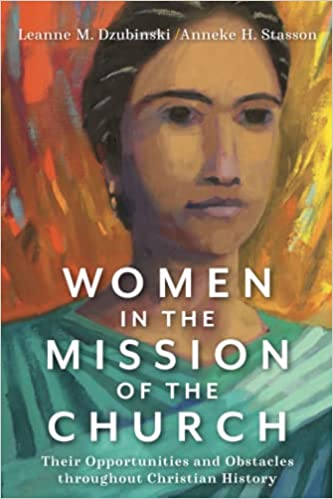A Book Review from Books At a Glance
by Andrew Ballitch
Summary and Review
Authors Leanne Dzubinski and Anneke Stasson take a breadth rather than depth approach to surveying church history for women and their role in shaping that history. Their interpretive framework, per the subtitle of the book, is an emphasis on both the opportunities and obstacles presented to women in Christian history. They argue, according to their explicit thesis, that “women have been integral to the mission of the church but have faced gender-based obstacles” (185). They offer evidence for this claim in three parts and nine chapters, largely working chronologically from the early church through the twentieth century.
Part one handles women’s leadership in the earliest centuries of Christian history. The two chapters that make up this section enumerate biblical figures and their roles, such as Nympha, Lydia, Mary, Junia, Phoebe, Dorcas, and Priscilla. These women were influential patrons of house churches, missionaries, apostles, and widows. It was the earliest Christian generations that saw the martyrdom of women like Blandina, Perpetua, and Felicitas. The first few centuries of church history also saw the rise of monasticism, with women playing a significant role in shaping this movement through virginity, scholarship, and pioneer leadership. While the authors’ contention that Junia was a female apostle is hotly contested, their exegesis surrounding female deacons or deaconesses is sound.
Part two takes up the topic of women in late antiquity and the Middle Ages. Here we see the rise of mothers and sisters playing an outsized role in the lives of well-known pastors and theologians. Emmelia and Macrina were mother and sister respectively to three famous bishops, Basil the Great, Gregory of Nyssa, and Peter of Sabaste. Anthusa was the mother of John Chrysostom and Monica of Augustine. There were also empresses in the Byzantine Empire and Queens in the West who furthered the mission of the church through their patronage and their husbands. The later Middle Ages was the context for women becoming Christian leaders as nuns and mystics.
Part three looks at women’s leadership after the Protestant Reformation. A significant transition happened with the Reformation. The emphasis changed from virginity as a virtue to the domestic spheres of wife, mother, and homemaker. But the last four-hundred years have also given rise to women preachers during the First and Second Great Awakening especially, followed by similar roles in the Holiness Movement, and culminating in the ministry of one of the first mega-church pastors, Aimee Semple McPherson, founder of the Foursquare denomination. Women can also be found during this period serving as social justice advocates, missionaries, evangelists, and church founders. It is the authors’ assertion that women were welcome in leadership in the early days of various movements but were pushed to the margins with institutionalization, the assumption being that limiting women’s roles is bad. But couldn’t it be that pioneer fields and works have different standards than the institutional church when it comes to appropriate male and female roles? And that this might be accounted for by an adequately developed ecclesiology?
Dzubinski and Stasson offer a clear argument––“women have been absolutely essential to the mission of the church historically”––and overwhelming evidence to sustain it. They also provide some helpful definitions. Mission is “anything that leads to the extension of the church or to the deepening of Christian commitment, such as teaching, preaching, evangelizing, prophesying, and founding churches. Leadership is used “to signify having authority and influence in society.” At the same time, they articulate a refreshing balance, desiring “to challenge the assumption that the kingdom work of women and men in the public sphere is more important than their work in the domestic sphere” (6–7).
There is one technical matter that is glaringly absent from this study. The authors do not take a position on whether the New Testament labels of elder, pastor, and overseer are synonymous for the same office, and whether this office is (or these offices are) reserved exclusively for qualified men in local churches. Though they do not explicitly come down on this issue, at the same time they seem to carefully avoid allowing for women pastors. Here are a few instances:
- “It is common today to talk about a person being ‘called’ to be a pastor or missionary. In the early church, a women could be called to be a widow or a virgin or a deacon” (23–24).
- “The previous chapter introduced several types of vocations for Christian women in the early church: disciple, patron, missionary, evangelist, apostle, teacher, widow, and martyr. This chapter continues the discussion of vocations for women in the early church by discussing virgins, scholars, desert mothers, and deacons” (37).
- “In this section of 1 Timothy, Paul sets out qualifications for elders, deacons, and women deacons in the church in Ephesus” (46).
I imagine very few would argue categorically against women doing ministry or being part of accomplishing the mission of the church. But I suspect that most readers will be asking what legitimate part women are to play. By avoiding the issue, we are left to wonder whether the authors are unaware of the question or are being intentionally vague.
Overall, this book accomplishes its purpose. It includes timelines at the beginning of each chapter which aid with accessibility. The summary and recap sections that begin and conclude each chapter are clarifying if at times a bit tedious. The authors are largely disciplined at staying in the realm of description, which, given the current polemics over biblical manhood and womanhood, between egalitarians and complementarians, is equal parts frustrating and sublime. I recommend it. And if a future edition were to develop the pastor-elder-overseer role more precisely and in its rare prescriptive portions define it as a role exclusively for men, I would highly recommend it.
Reviewer Bio
Andrew S. Ballitch (PhD, The Southern Baptist Theological Seminary) is a pastor at Westwood Alliance Church in Mansfield, Ohio.
